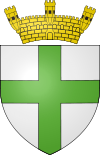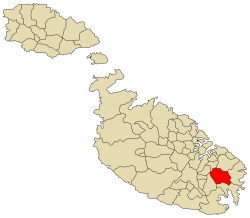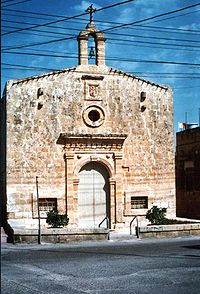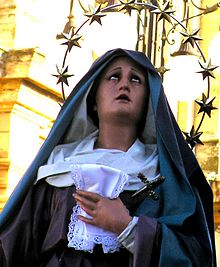- Żejtun
-
Zejtun
Il-Kunsill Lokali taż-Żejtun
Città Beland
Città Beland, Casal Santa Catarina;
Bisqallin; Casal Bisbut— Local council — Iż-Żejtun Aerial view of Żejtun with the Parish church at the center 
Coat of armsMotto: Città Beland (Frott iż-Żebbuġ Ismi) Coordinates: 35°51′20″N 14°32′0″E / 35.85556°N 14.533333°ECoordinates: 35°51′20″N 14°32′0″E / 35.85556°N 14.533333°E Country  Malta
MaltaIsland Malta District Borders Tarxien, Marsaxlokk, Għaxaq, Fgura, Żabbar, Marsaskala, Santa Luċija Government – Mayor Joseph Attard (MLP) Area – Total 7.4 km2 (2.9 sq mi) Population (9th largest locality) – Total 13,410 – Density 1,812.2/km2 (4,693.5/sq mi) Demonym Żejtuni (m), Żejtunija (f), Żwieten (pl) Time zone CET (UTC+1) – Summer (DST) CEST (UTC+2) Postal code ŻTN Dialing code 356 Patron saint St. Catherine of Alexandria Day of festa 3rd week of June Website Official website Żejtun is a medium sized town in the south of Malta. Żejtun holds the title of Città Beland, which was bestowed by Ferdinand von Hompesch zu Bolheim, Grandmaster of Knights of Malta in 1797, Beland being his mother's surname.
Żejtun takes its name from the Sicilian Arabic for “olive”- zaytun (comparable to the Spanish and Portuguese, "aceituna" and "azeitona" respectively), which was one of the main productive industries in Malta.[1] It is also known as Ħal-Bisbut, or Casal Bisbut.
The current archpriest is Fr. Eric Overend, while the mayor is Mr. Joe Attard. Żejtun population is projected to increase from 11,425 inhabitants in 2005 to 13,133 in 2010.
History
In Medieval times the whole district around Żejtun, that is the southern end of Malta, was known as le Terre di Santa Caterina, ( Italian for 'the lands of Saint Catherine', Italian being the official language in the period). During this period a number of new villages such as Ghaxaq and Marsaxlokk emerged from parts of the Parish of Żejtun. In the medieval years Zejtun was bordered by Zurrieq because Birzebugia was part of Zurrieq. they share the same patron Santa Katarina. most of these are today separate parishes. The local militia regiment of Żejtun was one of the first to engage the Ottoman forces in the initial stages of the Great Siege of 1565, but the town continued to suffer attacks by Turkish pirates up to 1614, when an attack by the Turks was repulsed without aid from other militias.[citation needed] The town served a minor role in the French Blockade of 1799/1801 as a depot for soldiers. It was one of the first towns in Malta, outside the main fortified areas of Malta, to boast a Public Garden. This garden, the Luqa Briffa Garden, still stands today. It is named after a famous cavalryman during the Great Siege of Malta.
Żejtun passed the British-rule of the Maltese islands as a rural-backwater in the green fields of the Mazza Valley. In this period it had one of the many hospitals in Malta for wounded British and French soldiers in the First World War, which hospitals earned the island the nickname of the Nurse of the Mediterranean. Since Malta's Independence, the town expanded rapidly due to home-ownership-schemes, industrial estates and housing estates built around the old village core.
Local Council
The members of the current Local Council elected following the election held on 8 March 2008 are:
- Joe Attard BA(Hons), Mayor
- Joan Agius, Deputy Mayor
- Darrell Pace, Councillor
- Claude C. Camilleri, Councillor
- Richard Darmanin, Councillor
- Joseph Hales, Councillor
- Stephania Fenech B.A. (Hons) Youth and Community Studies, Councillor
- Anthony Seychell, Councillor
- Elisabeth Wille Piscopo, Councillor
Following the amendments to the Local Councils Act of 2009, the term of the current local council was extended from three to five years.
The current Executive Secretary to the Town Council is Mr. Anton Falzon
Churches, Chapels and Remains
The village contains various Roman remains, including a Roman Villa, and a Church dedicated to Saint Catherine of Alexandria. The foundation stone was blessed in 1692 and the first archpriest was Dun Pawl Branchel. This Church, which was eventually finished in 1720, was the follower of a previous one, which still stands today on the edge of the town, which was also dedicated to Saint Catherine, but is colloquially known as Saint Gregory's, probably due to the annual procession dedicated to that saint, which in Medieval Times used to start from as far as Mdina.
Żejtun boasts a large number of chapels such as the one dedicated to St. Clement[disambiguation needed
 ] (San Klement), Our Lady of Good Counsel (Il-Madonna tal-Bon Kunsill), The Saviour (Is-Salvatur) and The Assumption (known as Santa Marija in Maltese), The Holy Spirit (L-Ispirtu Santu), St. Angelo (Sant' Anġlu), St. Nicholas (San Niklaw), Our Lady of Mercy (Il-Madonna tal-Ħniena), Our Lady of Lourdes (Il-Madonna ta' Lourdes), Our Lady of Signora (Il-Madonna tas-Sinjura), and St. Mary of Hal Tmiem (Santa Marija ta' Ħal-Tmiem). Other chapels that in the recent past were part of the Żejtun parish are of St. Anthony (Sant' Antnin) and San Gejtanu in the limits of St. Thomas Bay.
] (San Klement), Our Lady of Good Counsel (Il-Madonna tal-Bon Kunsill), The Saviour (Is-Salvatur) and The Assumption (known as Santa Marija in Maltese), The Holy Spirit (L-Ispirtu Santu), St. Angelo (Sant' Anġlu), St. Nicholas (San Niklaw), Our Lady of Mercy (Il-Madonna tal-Ħniena), Our Lady of Lourdes (Il-Madonna ta' Lourdes), Our Lady of Signora (Il-Madonna tas-Sinjura), and St. Mary of Hal Tmiem (Santa Marija ta' Ħal-Tmiem). Other chapels that in the recent past were part of the Żejtun parish are of St. Anthony (Sant' Antnin) and San Gejtanu in the limits of St. Thomas Bay.Devotion to Our Lady of Sorrows
The devotion to Our Lady of Sorrows in the Maltese Islands is very strong. In Żejtun this devotion is alive in churches, streets and also in homes.
The Village Feast
The statue of Our Lady of Sorrows
The most important event which takes place in the town during the year is the feast of St. Catherine of Alexandria, which is celebrated in summer and not in the traditional date of 25 November. On this day Żejtun's two rival musical bands, the Banda Beland and the Żejtun Band, perform at Gregory Bonnici Square. The anthem dedicated to St. Catherine of Alexandria, sung in Żejtun during the feast, was written by Emmanuele Palmier-Cecy while it was composed by Dun Lawrenz Mifsud. Until the mid-1970s Żejtun used to celebrate the Feast of Our Lady of Doctrine as a secondary feast.
Parish Church (Il-Parroċċa ta' Santa Katarina)
In the parish church one can find a crucifix, the 'sotto quadro', that portrays the Jesus Christ dead on his mother Mary. This work of art is attributed to Antonio Mamo and was made in 1727 for a sum of 40 scuds. In the feast of Our Lady of Sorrows this chapel decorated with damasc.
Also in the parish church, in the chapel of Our Lady of Charity one can find the painting that represent The Madonna with John under the cross. This painting depicts the Gospel of John when Jesus Christ from the cross told: "Woman, here is your son", and then told to the apostle: "Here is your mother." This painting is attributed to the artist from Żejtun, Toussaints Busuttil (1912–1994). In the museum of the parish church one can also find another painting that represent the sorrow that passed from it Mary.
Apart from these paintings, in the parish church there is also statues that march in the procession of Good Friday. One is known by the people of Żejtun as 'Tal-Pietà' (of Pietà). This is a statue with four figures. The Madonna with Jesus dead on her with Joseph from Arimathea and Nicodemo. This statue is made in Lecce by the firm Capoccia and was done on copy of the statue of the famous Michelangelo in St. Peter's Basilica. This statue was brought to Żejtun in 1965 by Frankie Grima.
The other statue that is known by the Żejtun people as 'il-Vara tad-Duluri' (Our Lady of Sorrows' Statue), portraying Our Lady that was made in Lecce and a small angel near her. In the beginning of the last century there was also another angel with Our Lady, this one was in standing position. But in World War I this angel was removed and another angel was added in a sitting position, by the artist from Qormi, Ġużeppi Cilia.
In the middle of the 20th century this angel also removed and was replaced by a statue of Saint John by Cav. Wistin Camilleri (1885–1979). But after a few years this statue was removed and the original sitting angel was restored. In 2005, a new statue of St John was made by Alfred Camilleri Cauchi, which will take the place of the angel once again.
This statue of Our Lady of Sorrows (Duluri), apart from March in the Good Friday procession with the eleven other statues of Żejtun, also march in the procession of Our Lady of Sorrows (il-purċissjoni tad-Duluri), that took place the Friday before Palm Sunday.
In the past the procession of the 'Duluri' was only on Good Friday. After the statue left, many children and women with 'faldetta' would pray at the Rosary.
The Oratory (L-Oratorju)
In the oratory there is also a stone artwork that represents Our Lady of Sorrows with Jesus and under them are portrayed the souls of purgatory. This altar is all done by Maltese stone. This altar in the feast of All Souls' Day, in November was open for adoration.
Holy Ghost Church (Il-Knisja ta' l-Ispirtu s-Santu)
Few meters away from the Parish Church there is the church of the Holy Ghost (L-Ispirtu s-Santu), where ne of the three altars in this church is dedicated to Our Lady of Sorrows. There is a painting of Toussaints Busuttil, that was made in 1945. But this is not the first painting in this church under this title.
Jesus of Nazareth Church (Il-Knisja ta' Ġesù Nazzarenu)
In the Church of Jesus of Nazareth there is an altar dedicated to Our Lady of Sorrows. The figure of Mary is in the standing position and a small angel holds the crone of Jesus. This is a work in marble that was made in a foreign country and was ordered by the Bishop Emanuel Galea (1891–1974).
Our Lady of Mercy Church (Il-Knisja tal-Madonna tal-Ħniena)
Another center of devotion to Our Lady of Sorrows in Żejtun, is the church of Our Lady of Mercy (Madonna tal-Ħniena), in the zone of Bir id-Deheb. In 1575 a church already existed in this place, but in 1618 Bishop Cagliares ordered its closure. Three years later the Bishop reopened this church, dedicating it to St Mary but giving it the title of Our Lady of Mercy.
In 1659 this church closed for another time and the altar transferred to the church of Santa Marija tal-Ħlas, also in Żejtun. It reopened for the second time in 1677.
St Mary of Ħal-Tmiem Church (Il-Knisja ta' Santa Marija ta' Ħal-Tmiem)
In the church of Santa Marija ta' Ħal-Tmiem (St Mary of Hal-Tmiem) there is a statue of Our Lady of Sorrows that is copy of the statue of the parish church.
Madonna della Signora Church (Il-Knisja tas-Sinjura)
In this church, known by the residents as 'Tas-Sinjura', there is a bust of Our Lady of Sorrows under a big cross that found in this church.
St Gregory Church (Il-Knisja ta' San Girgor)
Also in the church of St Gregory, that was the parish church of Żejtun before today's parish church, there is a statue of Our Lady of Sorrows on a rock, in the chapel of Our Lady of Monte Carmel.
St Clement Church (Il-Knisja ta' San Klement)
In the church of St Clement there is a painting by Francesco Zahra. In this painting one can find the Madonna with Jesus on her ans some small angels. This painting some years ago was arranged by the Żejtun painter Twanny Spagnol.
St Nicholas (il Kappella ta' San Niklaw)
Though it is not precisely known when this Chapel of St Nicholas was erected, references made in old documents relate to the year 1504. Nonetheless in 1640 the chapel was rebuilt reflecting 17th centaury architecture. The Feast of St Nicholas is still celebrated every year in this small hamlet of Zejtun on the 6th of December.
In Żejtun's streets
In Żejtun's streets find also four niches represent Our Lady of Sorrows. This niches find in Triq il-Ħerba, Triq il-Madonna tal-Ħniena (Our Lady of Mercy Street), another in Triq Licata and also one in Pjazza Bandolier.
In Żejtun there are also two streets dedicated to Our Lady of Sorrows. These are Triq il-Madonna tal-Ħniena (Our Lady of Mercy Street) that connect the zone of Bir id-Deheb with the centre of the city, and another street that connect the centre of Żejtun with the housing estate of Ta' Ganza with the name of Triq id-Duluri (Our Lady of Sorrows Street).
The devotion to Our Lady of Sorrows among the people of Zejtun is still strong to this day. Numerous people come from Żejtun and other Maltese localities of Malta to take part in the Our Lady of Sorrows procession.
Personalities
Żejtun is considered as the hub of Maltese folk singing, l-għana and the town has given Malta many of its most respected folk singers.
These include Pawlu Seychell l-Għannej (1907–1992), Pawlu Degabriele il-Bies (1908–1980), Mikiel Abela il-Bambinu (1920–1991) and Frans Baldacchino il-Budaj (1943–2006) . Famous current Żejtun folksingers include Fredu Abela iż-Żejtuni and Mikiel Cutajar is-Superstar.
Renowned author Trevor Żahra and traditional instrument maker Ġużi Gatt also hail from Żejtun. Also named for producing the local Talented Mro. Carlo Diacono who was one of Malta's distinguished composers of sacred music. He also conducted his father's band Beland band club.
Gillian Attard grew up in the southern town of Zejtun is a Maltese actress, singer and a famous personality on Maltese television.
Gregory Bonici Square (in Maltese, Misraħ Girgor Bonici), is the main square in the centre of Żejtun, Malta. To Żejtun inhabitants it is known as 'Il-Pjazza' (the square). In the past this square, also with Republic Square (Misraħ ir-Repubblika), was known as Pjazza Maġġura (Major Square).
Gregory Bonnici was the Governor of Mdina from 1654 to 1655. In 1653 he was the Ambassador of the Popular Council of Malta, in Licata, Sicily. In 1670 he built the Church of St. Angelo in Żejtun. He lived near this church at the grand palace Aedes Danielis.
Bonnici gave the land and the interest of his wealth to build the present parish church of Żejtun in 1692.
In this square (misraħ) stands a large cross that was brought here in 1850, in place of another much older. The previous cross was brought by the Żejtun Militia Battalion during the Blockade of 1798–1800 against the occupying French troops. The cross had originally stood in the forecourt of the Santa Liberata Convent in Kalkara, where the Battalion had an outpost and battery guarding St. Salvatore Gate, should the French attempt any foraging skirmish due to the hunger within the walls.
Schools
The Girl's Junior Lyceum (High School), named after composer Carlo Diacono, is located close to Saint Gregory's Church in Żejtun. The Primary School, built in Neo-Classical style during the British Colonial era, consists of two primary schools, Żejtun Primary 'A' Dun Alwiġ Camilleri and Żejtun Primary 'B'. A Kindergarten School and a church school, the Theresa Nuzzo School, can also be found in Żejtun.
Public Transport
The main bus routes in Zejtun is number 81. Routes 82, 119, 135, N81 and N82 also pass through the city.
- Route 81 is from Marsaxlokk to Valletta and vice-versa. This route passes from Ghar Dalam Road (bus stages Deheb 3, Deheb 4), Tal-Barrani Road (bus stages Deheb 1, Deheb 2, Santu, Beland, Belt and Bulebel), Bir id-Deheb Road (bus stages Ghadam and Haddiema), Labour Road (bus stage Farrugia), 25th November Avenue (bus stages Diacono and Novembru), and Carlo Diacono Square (bus stage Iz-Zejtun).
- Route 82 is from Birzebbuga to Valletta and vice-versa. This route passes from Ghar Dalam Road (bus stages Deheb 3 and Deheb 4), Tal-Barrani Road (stages Deheb 1, Deheb 2, Barrani, Santu, Beland, Belt and Bulebel).
- Route 135 is from Malta International Airport to Marsaskala and vice-versa. This route passes from Tal-Barrani Road (bus stage Deheb 1), Bir id-Deheb Road ((bus stages Ghadam and Haddiema), Labour Road (bus stage Farrugia), 25th November Avenue (bus stage Diacono), Carlo Diacono Square (bus stage Iz-Zejtun), Mater Boni Consigli Street, Gregory Bonici Square, Republic Square (bus stage Gwiedi), St. Gregory Street (bus stage Wistin), Bishop Emmanuele Galea Street (bus stages Isqof, Crieki and Giebga), Qadi Street (bus stage Huxlief), St. Thomas Bay Road (bus stages Girgor, Tmiem, Herba and Xaghri), Xrobb l-Ghagin Road and President Anton Buttigieg Street (bus stages President, Lawrenz, Anton and Buttigieg).
- Route 119 from Birzebbuga to Marsaskala and vice-versa. This route passes from Xrobb l-Ghagin Road (bus stage Strejnu) and St. Thomas Bay Road (bus stages Girgor, Tmiem, Herba and Xaghri).
- There was also route 124 from Bir id-Deheb to Marsaskala and vice-versa. This route was passing from Tal-Barrani Road (bus stages Deheb 1 and Deheb 2), Bir id-Deheb Road(bus stages Ghadam and Haddiema), Labour Road (bus stage Farrugia), Alfredo Cachia Zammit Street (bus stages Alfredo and Mattei), Ghajn tal-Bhejjem Square (bus stage Theuma), and Cospicua Road (bus stages Merhla and Ghollieq). This route stoped after one month of the new Arriva network.
Zones in Żejtun
- Bir id-Deheb
- Bisqallin
- Bulebel Industrial Estate
- Ġebel San Martin
- Gwiedi, (Il-Gwiedi) is the zone in front of the parish church of Żejtun. This zone was the most important zone of this city, because in the past lived there many nobile families of Żejtun.
The word "Gwiedi" is the plural of "Gudja", that means a small circular hill. And is also a popular name of many estates in Malta. One of them is the locality of Gudja.
- Ħajt il-Wied
- Ħal-Bisbut
- Ħal-Ġwann
- Ħal-Tmiem
- Ta' Ganza
- Tal-Barrani
Notes
References
- Il-Baħar Rasu Iebsa, by Lino Psaila
- Għaqda Banda Żejtun, 2007 Festa Magazine
- Iż-Żejtun Magazine, June 2007
- Pg. 23, L-Aħħar Ikla Ċentru Parrokkjali
- Pg. 15, Mejda ta' l-Appostli Domus Sagra Familja
- Pg. 82/83,Purċissjonijiet tal-Ġimgħa l-Kbira (PIN)
- Pg. 25,Armar Żejtun 2001
- Pg. 9, Jum il-Mulej
- pg. 220 Teżori fil-Knejjes Maltin (PIN)
External links
 Cities in Malta
Cities in MaltaIl-Birgu (Città Vittoriosa) · Bormla (Città Cospicua) · L-Imdina (Città Notabile) · Ħal Qormi (Città Pinto) · Ir-Rabat, Għawdex (Città Vittoria) · L-Isla (Città Invicta) · Is-Siġġiewi (Città Ferdinand) · Valletta (Città Umillisima) · Ħaż-Żabbar (Città Hompesch) · Ħaż-Żebbuġ (Città Rohan) · Iż-Żejtun (Città Beland)
Categories:
Wikimedia Foundation. 2010.




